Managing the lygus bug in greenhouse crops
Learn about lygus bug biology, life cycle and management in greenhouse vegetable production.
ISSN 1198-712X, Published 2012
Introduction
The lygus bug (Figure 1), or tarnished plant bug, is widespread in North America and is found on a wide range of wild plants and cultivated crops. It has been found on at least 385 plant species. It commonly infests greenhouse pepper and, to a lesser extent, greenhouse cucumbers. Although it can feed on tomatoes, it is seldom a problem in this crop. In greenhouse ornamental production, it is primarily a problem in situations with reduced pesticide use, for example, where biological control is being used. It can damage crops such as chrysanthemum and gerbera and disrupt biocontrol programs.
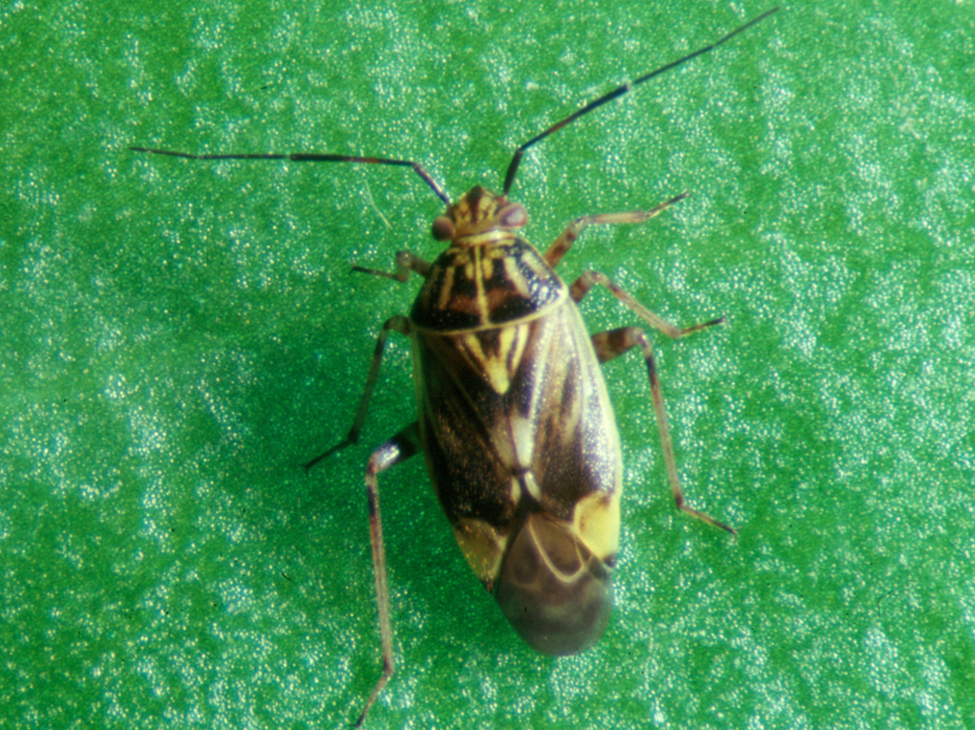
Description
The colour of the adult lygus bug is variable, being greenish or brownish, with reddish-brown markings on the wings. It is flat, oval-shaped and about 5-6 mm long by 2.5-3.0 mm wide, with the females tending to be larger than the males. The immature stages or nymphs are similar in form and yellowish green. First-stage nymphs are about 1 mm long and about 0.5 mm wide. Fifth-stage nymphs have noticeable wing pads and are about 3-4 mm long and about 2 mm wide. Nymphs characteristically walk rapidly and drop readily when disturbed.
Overwintered adults often do not resemble new generation adults in colour and form, and are frequently considered a different species by the casual observer. The intensity and extent of the colour pattern, and differences between males and females, are probably influenced by temperature, humidity, sunlight, host plant and age of the individuals. The predominant and only important Lygus pest species in Ontario is Lygus lineolaris.
Biology and life cycle
Lygus bugs overwinter as adults in sheltered areas, such as leaf litter, under bark, between leaves of plants and long dry grasses. They usually begin emerging from these sites in April and early May at temperatures as low as 8°C, and start to feed, mate and lay eggs in young plant tissue. Although multiple matings occur, a single mating is sufficient for a female to lay viable eggs for the rest of her life. Eggs incubate for about 7-12 days, depending on temperature. At 20°C, the optimum egg-laying temperature, each female lays an average of 96 eggs, but this number can be as many as 140. Females live for about 52 days at 20°C, and 37 days at 28°C. The hatched immatures or nymphs (Figure 2) pass through five nymphal stages, and new generation adults appear after about 30-45 days.
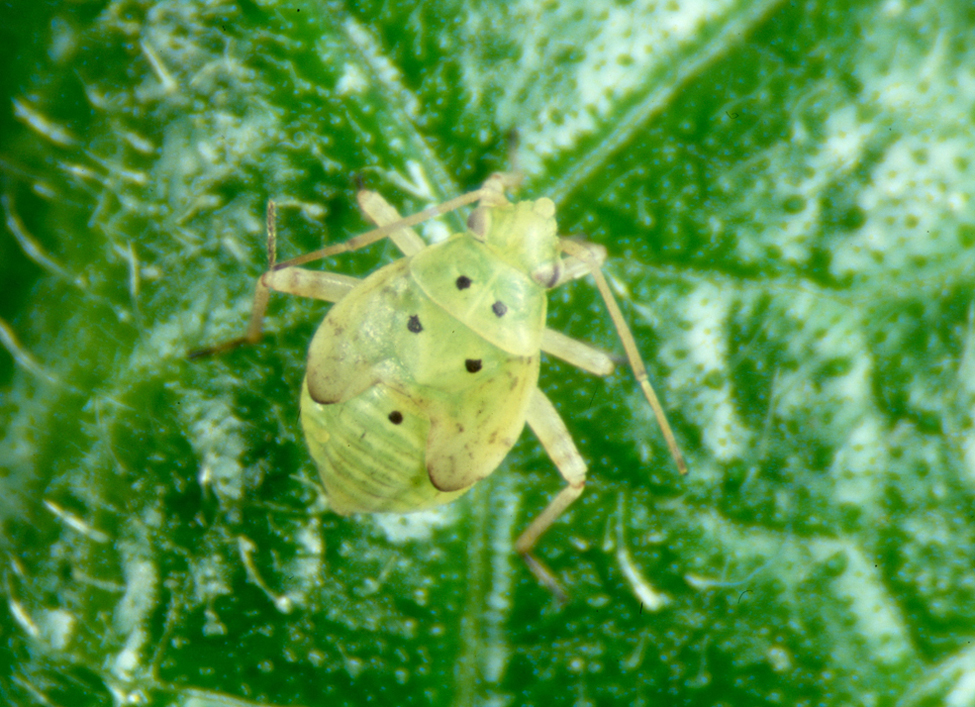
Eggs laid by summer adults produce adults 20-25 days later. Adults live for 1-2 months. Overwintered adults often overlap with the new generation adults for several weeks but numbers of the new generation are greater.
When day length shortens to 12.5 hours or less, diapause is induced in the nymphs and manifested in the adults. However, continuous light prevents diapause in young adults and terminates diapause in adults already in diapause.
Damage
The lygus bug feeds on a wide range of seed, vegetable, fruit, fibre and forage crops. Lygus bugs have a particular preference for young developing tissue and immature fruit. As such, their damage in peppers is often manifested by development of multiple shoots, distortion of flowers and young fruits (Figure 3), and shedding of floral buds. Damage caused by these bugs in cucumbers could include destruction of the growing point of young seedlings and "ragging" of leaves which appear crinkled and may have several holes (Figure 4).
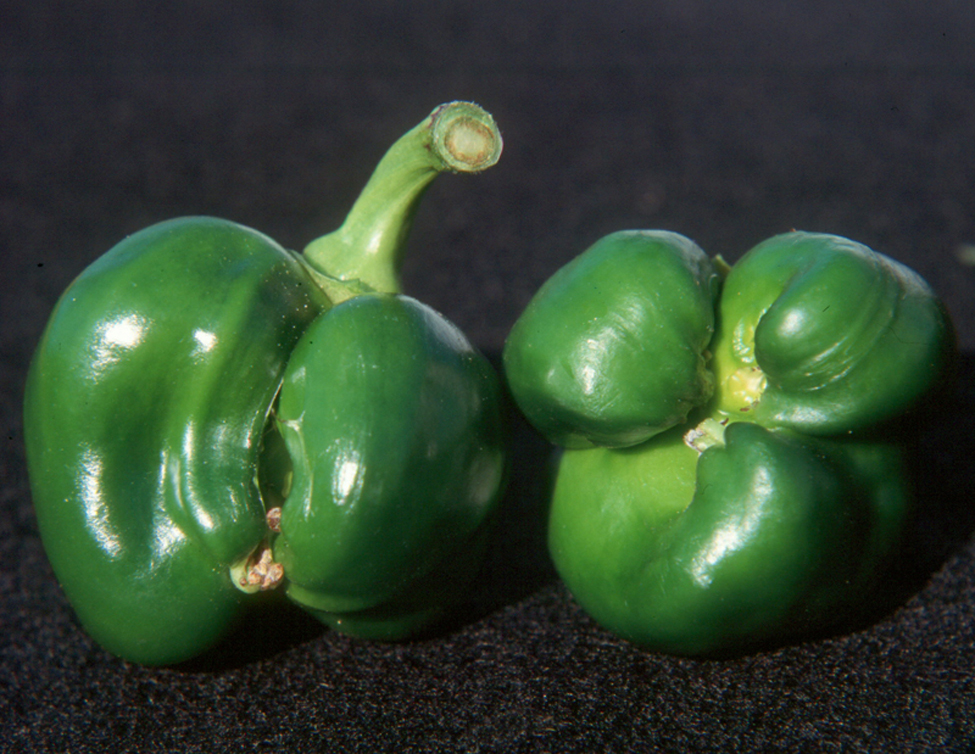
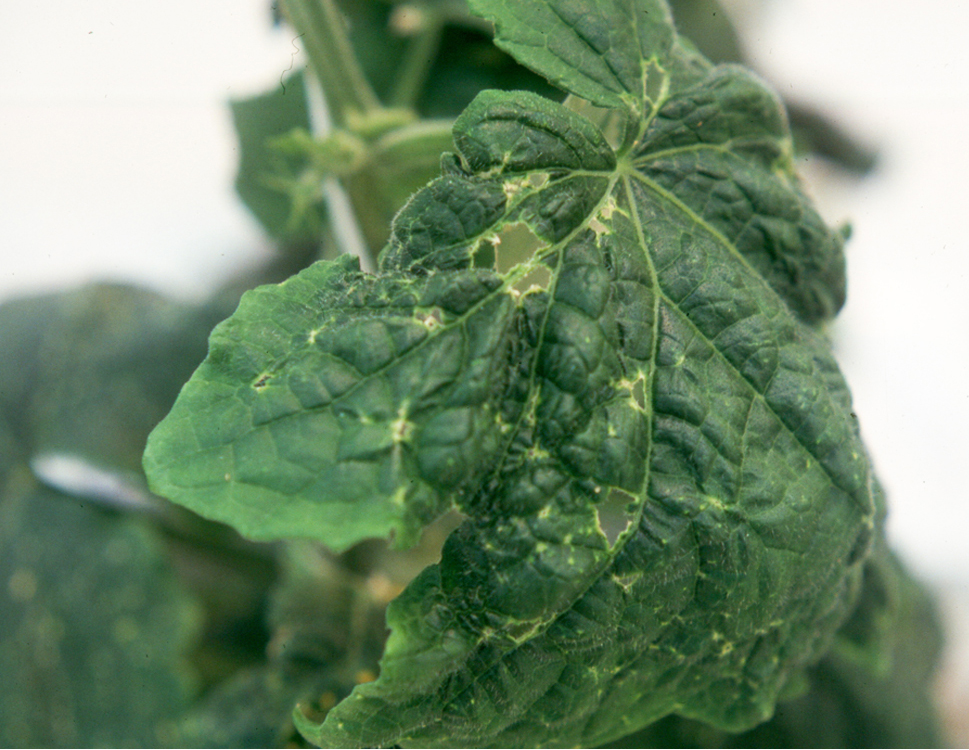
In ornamental crops, such as chrysanthemum, feeding by lygus bugs causes malformation of the flowers (Figure 5) and foliage (Figure 6).
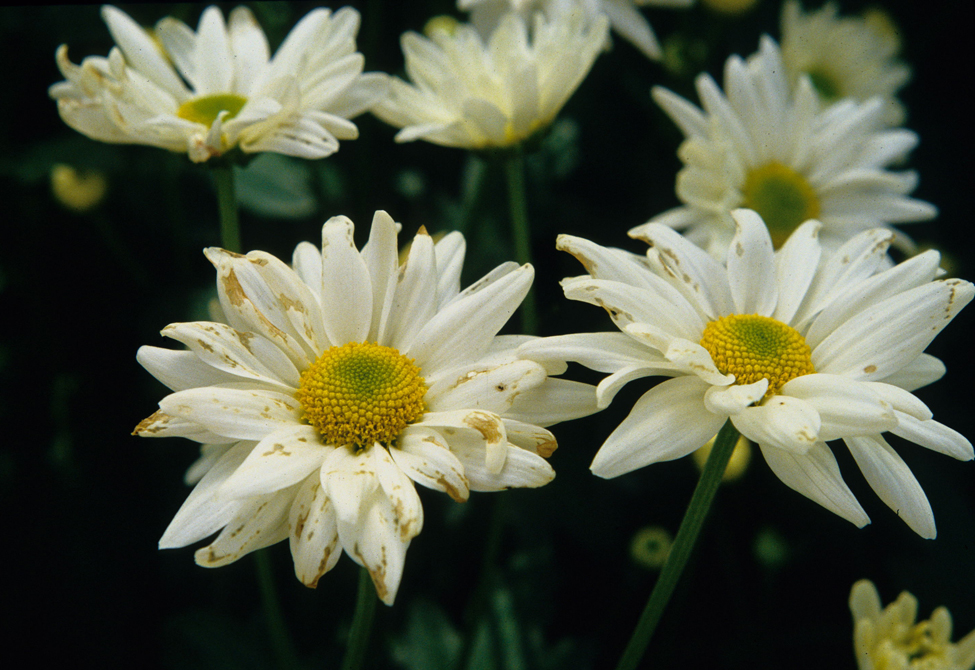
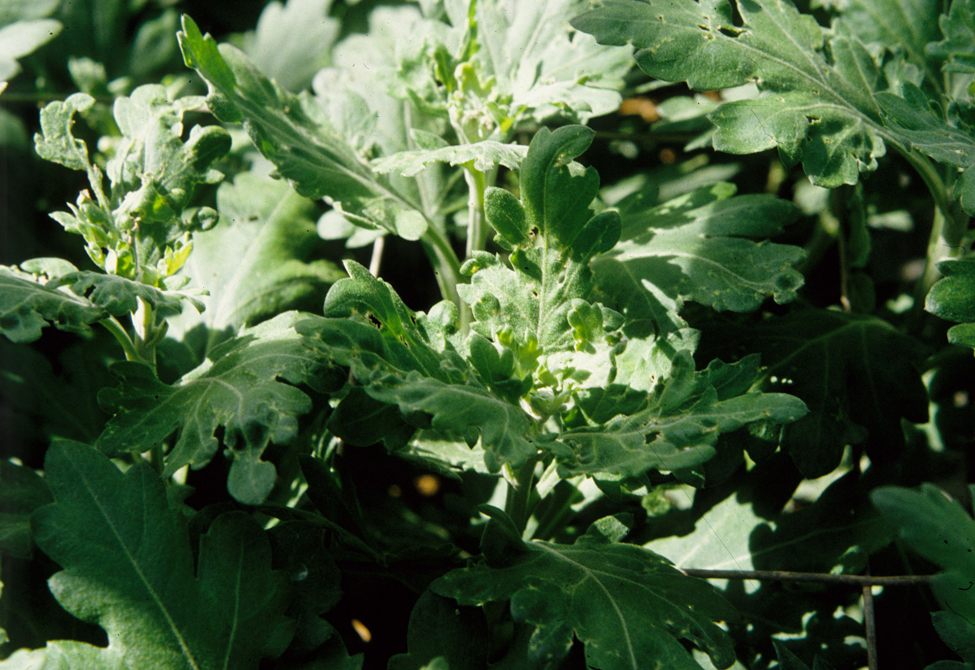
Malformations resulting from feeding by lygus bugs are considered by some researchers to be caused by:
- feeding on rapidly growing young tissues
- mechanical destruction of growing tissues by the insect's mouth parts
- chemical destruction of cells by salivary enzymes produced by the bugs
- inhibition of growth of the injured part by substances induced by feeding of the bugs
- promotion of growth in surrounding tissues by plant growth-promoting substances in the bug's saliva
Management
Movement of lygus bugs into greenhouse crops occurs each spring. This is especially problematic because the majority of vegetable growers and an increasing number of flower growers rely on biological control agents for managing most of their insect and mite pests. However, to date, there are no commercially available biological control agents that specifically target the lygus bug.
Some management strategies for this pest include the following:
Monitoring
Sticky cards and crop inspection: Monitoring of sticky cards and the upper canopy of the crop is essential for early detection of the lygus bug. Yellow sticky cards used for monitoring other pests in greenhouse crops also attract the lygus bug. Regular examination of the young flowers and leaves of peppers and cucumbers also helps detect their presence and provides an indication of the population level in the crop.
Cultural
Weed control: Weed suppression in the immediate vicinity of the greenhouse helps prevent the development of large populations in the area. Timing of weed removal is important. Mowing or brush cutting in spring will force resident populations in the weeds to migrate into the greenhouse and cause greater problems. Weed control is therefore best done during the fall to discourage overwintering in these areas. A wide, well-mowed strip surrounding the greenhouse is recommended.
Physical
Screening: Placing insect barriers over vents, doorways and other openings into the greenhouse will significantly reduce chances of entry of this flying bug into the greenhouse. Because lygus is a relatively large insect, the largest mesh size of screening is adequate for exclusion. It will have the additional benefit of excluding other larger insects such as moths, with minimal impact on airflow.
Biological
Orius insidiosus: Anecdotal reports indicate that high populations of the predatory bug, Orius insidiosus, in greenhouse pepper operations are associated with suppression of lygus bug populations. Indeed, researchers at Agriculture and Agri-Food Canada have observed Orius adults attacking small lygus nymphs.
Beauveria bassiana: This beneficial fungal control agent has a wide host range (>700 insect species), including lygus bugs. Research in Ontario and elsewhere has demonstrated that B. bassiana can provide effective control of lygus bugs. Although it is not specifically registered for use against lygus bugs, it is registered for use against other greenhouse pests in Ontario.
Chemical
For products that are registered for use against lygus bugs, see OMAFRA Publication 835, Crop Protection Guide for Greenhouse Vegetables and Publication 370, Guide to greenhouse floriculture production.
References
Bostanian, N.J. 1994. The tarnished plant bug and strawberry production. Research Branch, Agriculture and Agri-Food Canada, Technical Bulletin 1994-1E.
Kelton, L.A. 1975. The lygus bugs (genus Lygus Hahn) of North America (Heteroptera: Miridae). Mem. Ent. Soc. Can. 95: 1-101.
Khattat, A.R. and R., K. Stewart. 1977. Development and survival of Lygus lineolaris exposed to different laboratory rearing conditions. Annals of the Entomological Society of America 70: 274-278
Schwartz, M.D., R.G. Foottit. 1992. Lygus bugs on the prairies: biology, systematics and distribution. Research Branch, Agriculture Canada, Technical Bulletin 1992-4E: 46 pp.
Ugine, T.A. 2011. The effect of temperature and exposure to Beauveria bassiana on tarnished plant bug Lygus lineolaris (Heteroptera: Miridae) population dynamics, and the broader implications of treating insects with entomopathogenic fungi over a range of temperatures. Biological Control, Volume 59, Issue 3, pp. 373-383.
This fact sheet was authored by Gillian Ferguson, greenhouse vegetable IPM specialist, OMAFRA, Harrow; Graeme Murphy, greenhouse floriculture integrated pest management specialist, OMAFRA, Vineland; and Les Shipp, greenhouse entomologist, Agriculture and Agri-Food Canada, Harrow. The authors gratefully acknowledge the review of this fact sheet by Dr. Bruce Broadbent, entomologist, Agriculture and Agri-food Canada, London.